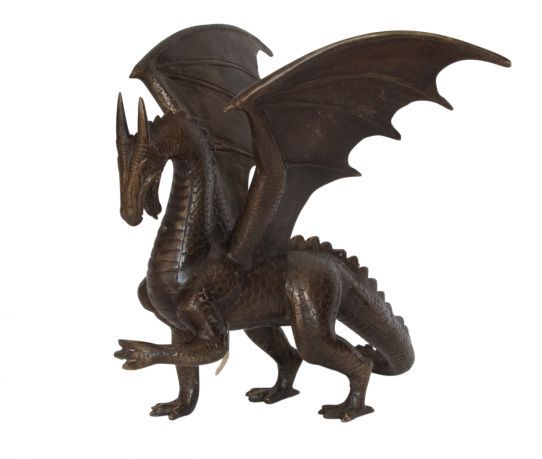We use cookies to make your experience better.
Bronze dragon - big
A dragon is a great mythical creature with a serpentine or otherwise reptilian body. The dragon plays a role in mythologies worldwide. Faith in these beings was possible because of the limited knowledge possessed by ancient cultures of the gigantic, prehistoric, 'dragon-like' reptiles. The word "dragon" is derived from the Greek δράκων (drakōn), [with which originally every kind of serpent was indicated. Whatever form the dragon later adopted in mythology, it remained essentially a snake. The European dragon, originating from different European mythologies, has many differences compared to the oriental dragon that is derived from the Chinese dragon. Since Psalm LXXIV, 13, the Apocalypse, XII, 3, the dragon has been presented as a monster with multiple heads (usually seven), a representation clearly inspired by ancient Mesopotamian iconography. The shape and appearance of a dragon varies per tradition. A dragon is often depicted with the body of a snake or a crocodile; claws and sometimes the head of an eagle, lion or falcon; bat wings (wings). In the Indies one can find elephant dragons and in China deer dragons. Many dragons are also classified with the serpents. They are also associated with fishy species. The terms are often used interchangeably. See also bestiary and the Fishboeck. The belief that a dragon spewed fire is sometimes attributed to the fact that a falling star was also called dragon. The trail that drew a falling star was then associated with the fiery breath of the dragon. Dragons symbolize different forces depending on culture. In pre-Christian Europe, the dragon was not necessarily considered unfavorable and often even favorable. Under Christianity, the dragon in Europe got a bad call and, as akin to the serpent from the Bible chapter Genesis, was presented as evil. In medieval Christianity, the dragon symbolized pre-Christian thought, the non-Christian, pagan world and also the fallen angel, the devil. Some well-known dragoncods are St. Michael, St. George, Perseus, Herakles, Apollon, Siegfried, King Arthur and Lancelot. Because of its fearsome appearance the dragon adorns many coats of arms and flags, the dragon is often used in heraldry. The dragon also occurs in names such as Drakensteyn and Drakenburg Castle.
In countries outside Europe, the dragon often brings good luck or offers protection against evil. In Mesopotamia the original almighty goddess who brought the other gods into the world was a dragon, see Mesopotamian mythology. In Egypt, Apepi was a god in dragon form who ruled over the underworld and over evil. In Greek myths drakontes are presented as smart, magical creatures that came from the earth, and the goddess Athena had a snake as a pet and helper.
| Dimensions | 300-350mm |
|---|












